 |
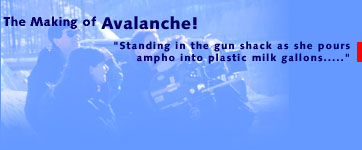
Off and Running | Preparing for the Slides
Swiss Snow Science | Fire in the Hole
Montana
Monday Nov. 4, 1996
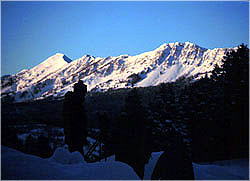 We fly to Bozeman, arriving after dark, and find our way to the Silver Forest
Inn in a snow squall. It is already winter here, which worries me.
We are supposed to be filming the early season, developing the characters, and
building anticipation for the coming of snow, winter, and the danger in the
mountains.
We fly to Bozeman, arriving after dark, and find our way to the Silver Forest
Inn in a snow squall. It is already winter here, which worries me.
We are supposed to be filming the early season, developing the characters, and
building anticipation for the coming of snow, winter, and the danger in the
mountains.
Tuesday Nov. 5
At Montana State University (MSU) we meet with the scientists. They are as
charming, interesting, and talkative as they were when Kate and I met them on
our research trip to the ISSW, or International Snow Science Workshop. But what
a lot of facial hair! Each and every one of them. And we plan to
shoot with them again mid-winter, so I tell them all not to shave, or the
audience won't recognize them.
Ed Adams takes me through the lab, and I get a chance to see the experiments
they are doing in the cold room. He explains that the little tiny balls of ice
I see in the world's smallest ice trays are models for snow, and sticking them
together and watching them attach to each other and then change over time is
going to help the scientists understand snow and how it bonds. As he talks, I
am surprised by how little scientists actually know about snow, and at the same
time struck by what a complex a material it is.
Wednesday Nov. 6
This day has been set aside to film a sequence in a helicopter with local
forecaster and researcher Karl Birkeland that will give us an
overview of the area and the research being done here. We're up before dawn,
and Bob, Dave and I meet Karl at the helipad on the south side of town. We have
cell phones and are talking to Kate who is over at Bridger Bowl looking at the
weather data. It isn't looking good, but we hold out hope. There are clouds
around, but maybe that is a break, maybe there is a hole...
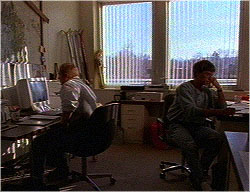 Finally around noon, we are forced to give up on filming with the helicopter,
and head over to meet Kate and Dave and Karl's partner Ron at the Forecast
Center to film the avalanche specialists in their other work environment.
About halfway through the shoot, we glance out the window to see that the
sun has come out and it looks like beautiful flying weather. But the lights are
in place, the camera is rolling, and so we continue where we are.
Finally around noon, we are forced to give up on filming with the helicopter,
and head over to meet Kate and Dave and Karl's partner Ron at the Forecast
Center to film the avalanche specialists in their other work environment.
About halfway through the shoot, we glance out the window to see that the
sun has come out and it looks like beautiful flying weather. But the lights are
in place, the camera is rolling, and so we continue where we are.
That night, we all meet for dinner in town. It is old home week for Bob around
here. The scientists know him. The forecasters know his friends. He went to
MSU. I'm teasing him that I am sick of people hugging him in the street. But he
is very funny and easy to be around. He really gives the crew a lift.
Thursday Nov. 7
 Another day begins, looking as frustrating as yesterday. We are hoping to fly
and again the weather isn't cooperating. We decide to give it up and leave, but
when we get back near the Bridgers, it starts to clear up. We call Karl, tear
back to the helipad, and give it a go. Karl, Dave and Bob join pilot Mark Duffy
in the Lama. It isn't perfect weather, so the ride is bumpy. And we
opted not to spend the money on expensive mounts. This isn't great for filming.
And it isn't great for Karl. As they fly over the Bridgers, he tries to
describes his research project. But he is getting sicker and sicker. He says a
couple of times "I'm feeling a little green."
Another day begins, looking as frustrating as yesterday. We are hoping to fly
and again the weather isn't cooperating. We decide to give it up and leave, but
when we get back near the Bridgers, it starts to clear up. We call Karl, tear
back to the helipad, and give it a go. Karl, Dave and Bob join pilot Mark Duffy
in the Lama. It isn't perfect weather, so the ride is bumpy. And we
opted not to spend the money on expensive mounts. This isn't great for filming.
And it isn't great for Karl. As they fly over the Bridgers, he tries to
describes his research project. But he is getting sicker and sicker. He says a
couple of times "I'm feeling a little green."
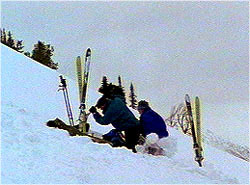 When they finally land to meet the rest of the crew, waiting with Ron by
snowmobile, he really IS green. But he gamely carries on and films a sequence
with us, putting climbing skins on the bottom of his skies to hike up to
Bradley Meadows, a scenic spot in the Bridgers. At this location he and Ron dig
a snowpit and demonstrate for us what tests they will be running and what
measurements they will be taking when they do the snowpit project later this
winter.
When they finally land to meet the rest of the crew, waiting with Ron by
snowmobile, he really IS green. But he gamely carries on and films a sequence
with us, putting climbing skins on the bottom of his skies to hike up to
Bradley Meadows, a scenic spot in the Bridgers. At this location he and Ron dig
a snowpit and demonstrate for us what tests they will be running and what
measurements they will be taking when they do the snowpit project later this
winter.
Friday Nov. 8
Again the weather is dicey. But we hear from Fay, the head of the ski patrol at
Bridger Bowl that they are planning to fly today. We are going to film a scene
where the ski area crew is helping the MSU researchers get ready for winter.
The research team maintains a site just north of the ski area in the Bridger
Range. It is a shack built onto the back of a rock, and it sits right in the
middle of an active avalanche path. When conditions are just right, they set
off avalanches and use equipment to gather data on densities, velocities,
depth, pressure and sheer strength, from inside an avalanche.
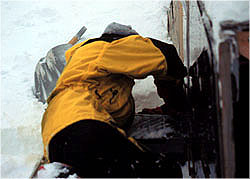 The ski area isn't open yet. It is scheduled to open in a week. On the day that
Bridger Bowl flies its bombs to the ridgetop, they traditionally help the MSU
researchers get their heavy equipment flown up to the research site. They need
to fly up a generator to run computers and some lumber to repair the shack from
Marmot damage. This is the one time during the year that they access the site
by helicopter. Later they will hike on their skis, and everything they need
will have to be carried.
The ski area isn't open yet. It is scheduled to open in a week. On the day that
Bridger Bowl flies its bombs to the ridgetop, they traditionally help the MSU
researchers get their heavy equipment flown up to the research site. They need
to fly up a generator to run computers and some lumber to repair the shack from
Marmot damage. This is the one time during the year that they access the site
by helicopter. Later they will hike on their skis, and everything they need
will have to be carried.
Fay arranges for mountain manager Randy Elliott to drive us in a snowcat up the
ski area to the helicopter staging area. Fay follows us on a snowmobile, and we
realize this is another filming opportunity. Here is a woman who is head of the
ski patrol at a small mountain that has some of the most extreme, and most
avalanche prone, terrain in the country. And she is organizing for the winter
and making bombs, and leading a crew that is getting ready for the season. She
is willing to help us out with filming the MSU researchers, but we decide to
film her work too.
 Fay isn't more than an inch or two over five feet tall, with short
dark hair. Despite the fact that Bridger has an extremely busy day ahead, she
is incredibly friendly and helpful to a film crew lugging around a lot of gear.
About halfway up the ski area, near the bomb cache that will be the staging
area, 4 large cargo nets are spread out on the wind scoured rock and snow.
Randy and Fay begin loading them with ski area supplies. Boxes of explosives,
trail signs, and toboggans used to bring injured skiers out are arranged on the
nets.
Fay isn't more than an inch or two over five feet tall, with short
dark hair. Despite the fact that Bridger has an extremely busy day ahead, she
is incredibly friendly and helpful to a film crew lugging around a lot of gear.
About halfway up the ski area, near the bomb cache that will be the staging
area, 4 large cargo nets are spread out on the wind scoured rock and snow.
Randy and Fay begin loading them with ski area supplies. Boxes of explosives,
trail signs, and toboggans used to bring injured skiers out are arranged on the
nets.
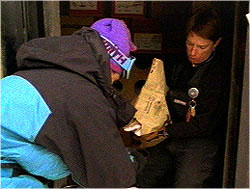 Once the nets are loaded, each with thirteen boxes of explosives, Fay sets her
mind to a new task—making jug bombs. Standing in the gun shack as she pours
ampho into plastic milk gallons, Fay tells us that these bombs provide "more
bang for your buck" and are relatively easy to make. After a really huge storm,
the jugbombs are easier to use than having to tape several hand charges
together. Fay systematically fills the jug, puts glue on the inside of the cap
and firmly puts the cap on top of the loaded jug, happily letting us interview
her as she works. After she makes a dozen bombs, Fay loads up each of the ski
patrol nets with three jug bombs.
Once the nets are loaded, each with thirteen boxes of explosives, Fay sets her
mind to a new task—making jug bombs. Standing in the gun shack as she pours
ampho into plastic milk gallons, Fay tells us that these bombs provide "more
bang for your buck" and are relatively easy to make. After a really huge storm,
the jugbombs are easier to use than having to tape several hand charges
together. Fay systematically fills the jug, puts glue on the inside of the cap
and firmly puts the cap on top of the loaded jug, happily letting us interview
her as she works. After she makes a dozen bombs, Fay loads up each of the ski
patrol nets with three jug bombs.
As we wait for the helicopter to start carrying the sling loads up to the
Ridge, we finish packing our combined MSU/NOVA cargo net. We have the
generator, lumber, tools and some new instrumentation from the MSU researchers
already in the net; to this load we add all of our skis, packs (there isn't
enough room inside the helicopter to have any packs or gear), and of course our
two boxes of lunch, which look disturbingly similar to the boxes of explosives.
As Fay picks up the lunch boxes she jokes about not wanting to lose them—and
making sure they are packed in tightly. In those two boxes we have lunch for
our crew and the MSU researchers whom we have told to not worry about bringing
food—we'll supply the lunch.
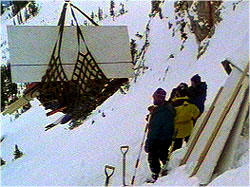 We have two helicopters flying today. One will be slinging loads up to the
ridge and over to the MSU site. The other will carry Bob and Dave so they can
film air to air, and then will shuttle the rest of us to the MSU site. Our
flight to the site is only a few minutes long, but it is my first ride in a
helicopter and it definitely gets my juices going! These ships can maneuver up
and down slopes, around trees, and land almost anywhere as long as you have
good conditions and a good pilot.
We have two helicopters flying today. One will be slinging loads up to the
ridge and over to the MSU site. The other will carry Bob and Dave so they can
film air to air, and then will shuttle the rest of us to the MSU site. Our
flight to the site is only a few minutes long, but it is my first ride in a
helicopter and it definitely gets my juices going! These ships can maneuver up
and down slopes, around trees, and land almost anywhere as long as you have
good conditions and a good pilot.
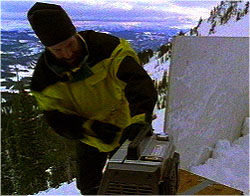 We arrive at the MSU site and reassemble. Bob and Dave have to warm up from
shooting on the ridge—the winds were strong. A call comes in over the walkie
talkie from the Lama heli pilot to let us know he is coming in with our load.
It looks like everything has made it safely. I am relieved to see that all of
our skis made it—I kept thinking about what the trip down would be like on one
ski. The MSU researchers get to work; before they unpack they start doing what
they all do well—shovel. Even though it is early November there are at least
four feet of snow covering the shack; winter has started early here. Next they
crank up the generator and start rebuilding the shack's roof. Scott and Jim
start working on fitting the metal covering for the velocity sensors into the
side wall.
We arrive at the MSU site and reassemble. Bob and Dave have to warm up from
shooting on the ridge—the winds were strong. A call comes in over the walkie
talkie from the Lama heli pilot to let us know he is coming in with our load.
It looks like everything has made it safely. I am relieved to see that all of
our skis made it—I kept thinking about what the trip down would be like on one
ski. The MSU researchers get to work; before they unpack they start doing what
they all do well—shovel. Even though it is early November there are at least
four feet of snow covering the shack; winter has started early here. Next they
crank up the generator and start rebuilding the shack's roof. Scott and Jim
start working on fitting the metal covering for the velocity sensors into the
side wall.
As they continue to work we hear Fay speaking to all patrollers over the radio.
Apparently someone saw a box fall from one of the sling loads while it was in
the air. They are concerned there is a box of bombs lying in the woods or on a
ski trail somewhere. She asks each team to count their boxes of explosives. The
teams report one by one that they do have their thirteen boxes. Fay then asks
us to check our load for a missing box. We look through and then it hits
me—there is only one lunch box! Kate opens the box (which is the smaller of
the two) and breaks the news to the scientists and crew that all we have to
feed 12 people are two sandwiches and one box of cookies. There is going to be
one happy marmot out there and a very hungry crew up here.
Despite the lack of food everyone stays in good cheer and we spend the
afternoon filming the researchers as they install a new instrument to measure
shear strength, adjust a "strain rosette" to measure elasticity of the snow,
and complete their work on the shack. The light is starting to go, so we all
pack up and ski down.
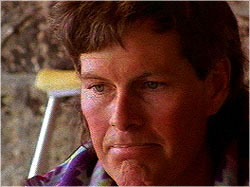 When we reach the ski area base, Fay tells us that the first avalanche accident
and rescue of the season happened this afternoon. Chris Stone,
a local skier, was out with his partner skiing the
backside of one of the peaks in the Bridger Range. Chris got caught in an
avalanche that took him for a ride of approximately 1000 vertical feet. He was
partially buried and with the help of his dog was able to dig himself out. His
partner had alerted the ski patrol I who were only in the area because they
were doing their pre-season bomb work) and Fay had coordinated an extremely
efficient rescue. Chris had just been airlifted out by the same pilot that we
were flying with today.
When we reach the ski area base, Fay tells us that the first avalanche accident
and rescue of the season happened this afternoon. Chris Stone,
a local skier, was out with his partner skiing the
backside of one of the peaks in the Bridger Range. Chris got caught in an
avalanche that took him for a ride of approximately 1000 vertical feet. He was
partially buried and with the help of his dog was able to dig himself out. His
partner had alerted the ski patrol I who were only in the area because they
were doing their pre-season bomb work) and Fay had coordinated an extremely
efficient rescue. Chris had just been airlifted out by the same pilot that we
were flying with today.
It seems too early in the season to be hearing this story, but it's also
stories like these that reveal the human cost of avalanches. Fay is telling us
all of these details as the sun is setting over the mountains. The sky looks
great and this is a very good story—and then I remember that we have no more
film. It is unbearable to think that we have a story and perfect lighting and
no film. Bob remembers he has a short end (a partial roll) back at the Inn and
races off to get it. I stand there with Fay, watching this beautiful sunset
fade and swearing to myself that I will never again be caught without a back-up
supply of film, especially on a weather related project where you really never
know what will happen. Kate is in the patrol shack calling any production
company that she can find listed in Bozeman, desperately trying to buy some
film. The fact that it is 5:30 on a Friday is not helping her efforts.
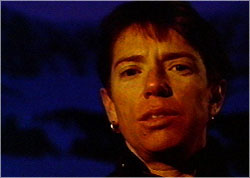 Bob comes racing back, ready to go and we do try to film Fay explaining what
has happened, but the sun is gone and I know it isn't going to look good. This
was supposed to be the last day of filming. We are all booked on flights
leaving tomorrow morning, but it is hard to leave without finishing this story.
We head into town to have our dinner and try to decide what we should do. Chris
Stone's story has spread pretty quickly around town. We hear that he has been
released from the hospital to go home, and aside from some bad bruises he is
fine. Different folks in town give us their opinions about whether Chris would
be interested in telling us his story.
Bob comes racing back, ready to go and we do try to film Fay explaining what
has happened, but the sun is gone and I know it isn't going to look good. This
was supposed to be the last day of filming. We are all booked on flights
leaving tomorrow morning, but it is hard to leave without finishing this story.
We head into town to have our dinner and try to decide what we should do. Chris
Stone's story has spread pretty quickly around town. We hear that he has been
released from the hospital to go home, and aside from some bad bruises he is
fine. Different folks in town give us their opinions about whether Chris would
be interested in telling us his story.
We decide to go for it—if he won't speak to us we're heading home anyway. The
next morning Kate starts trying to track him down, but his line seems to be
constantly busy. Finally she gets through, and after some discussion he agrees
to speak with us. It helps that he knows Bob. We head to his house, having
promised him we would only come over for a hour, and with 2 cans of film get
his interview in the can. He seems to still be in shock about the fact that he
could have died yesterday, so he gives us quite a reflective and compelling
interview, explaining what it was like to be caught in an avalanche.
Off and Running | Preparing for the Slides
Swiss Snow Science | Fire in the Hole
Photos: (1), (5) Kate Churchill/WGBH Educational Foundation; (2-4), (6-11) WGBH.
Capturing |
Making |
Elements |
Snow Sense |
Resources
Mail |
Teacher's Guide |
Transcript |
Avalanche Home
|